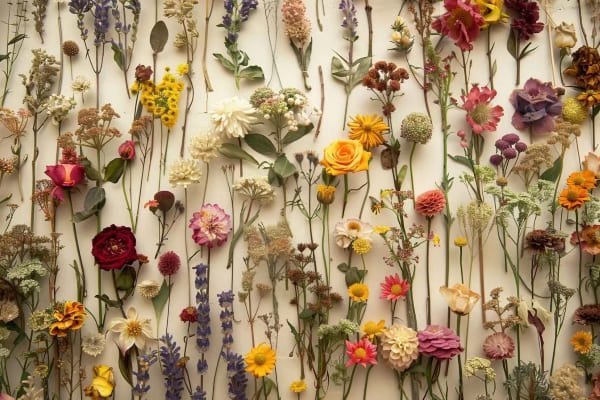


Dried flowers have long been cherished for their beauty and longevity, allowing nature's blooms to be enjoyed long after their season has passed. Whether you wish to preserve wedding bouquets, memorial flowers, or simply your favorite blooms, understanding the techniques for drying and preserving flowers can help you create lasting arrangements and keepsakes. This article delves into the various methods of drying and preserving flowers, exploring their benefits, challenges, and applications, to ensure that your flowers maintain their beauty and significance for years to come.
Before diving into the preservation techniques, it’s essential to understand the appeal and significance of dried flowers. Dried flowers have a timeless beauty that evokes a sense of nostalgia and natural elegance. They serve as lasting mementos of special occasions, such as weddings, anniversaries, or funerals, and can also be used in various crafts and decor.
1.1. Historical Context The practice of drying flowers dates back centuries, with cultures around the world using dried blooms in art, medicine, and religious rituals. In Victorian England, for example, dried flowers were used in "language of flowers" arrangements, where each flower conveyed a specific message or emotion.
1.2. Modern Appeal In modern times, dried flowers are enjoying a resurgence in popularity. They are favored for their sustainability, as they don’t require water or pesticides, and for their versatility in home decor, weddings, and other events.
Air drying is one of the oldest and most straightforward methods of preserving flowers. This technique is particularly well-suited for flowers with sturdy stems and small blooms, such as lavender, statice, and baby's breath.
2.1. The Process To air dry flowers, start by selecting fresh blooms at their peak. Remove any excess foliage from the stems and gather the flowers into small bundles. Tie the stems together with string or rubber bands and hang them upside down in a well-ventilated, dark room. The flowers should be spaced apart to allow for proper air circulation.
2.2. Drying Time The drying process typically takes two to three weeks, depending on the humidity and temperature of the room. Once the flowers are completely dry, they will have a papery texture and muted colors.
2.3. Benefits and Drawbacks
2.4. Applications Air-dried flowers are ideal for creating wreaths, bouquets, and other decorative arrangements. They can also be used in potpourri, sachets, or as embellishments in scrapbooking and other crafts.

Pressing flowers is another traditional method of preservation, particularly popular for creating two-dimensional keepsakes, such as framed art, bookmarks, and greeting cards.
3.1. The Process To press flowers, start by selecting fresh blooms that are relatively flat, such as pansies, daisies, or violets. Place the flowers between two sheets of absorbent paper, such as blotting paper or parchment paper. Then, place the paper inside a heavy book or press, and add more weight on top.
3.2. Drying Time The flowers should be left to press for two to four weeks, depending on the thickness of the blooms. Once fully dried, the flowers will be flat and delicate, with their colors slightly faded.
3.3. Benefits and Drawbacks
3.4. Applications Pressed flowers can be used to create framed art, stationery, bookmarks, or even incorporated into jewelry. They can also be laminated for added durability.
Silica gel drying is a more advanced method that involves using a desiccant to remove moisture from the flowers. This technique is highly effective at preserving the color and shape of the blooms, making it a popular choice for preserving special flowers like wedding bouquets.
4.1. The Process To dry flowers using silica gel, you’ll need a container, silica gel crystals, and fresh flowers. Begin by placing a layer of silica gel in the bottom of the container. Then, gently place the flowers on top, and carefully cover them with more silica gel, making sure to fill all the spaces around the petals. Seal the container and leave it in a dry, cool place.
4.2. Drying Time Silica gel drying is relatively fast, with most flowers drying completely within three to seven days. Once dry, carefully remove the flowers from the silica gel and brush off any excess crystals.
4.3. Benefits and Drawbacks
4.4. Applications Silica gel-dried flowers are ideal for creating intricate arrangements, shadow boxes, and other decor items where the preservation of color and form is essential.
Glycerin preservation is a method that involves replacing the natural moisture in the flowers with glycerin, which keeps the flowers soft and pliable. This technique is particularly effective for preserving foliage and large blooms, such as hydrangeas.
5.1. The Process To preserve flowers with glycerin, mix one part glycerin with two parts warm water. Submerge the stems of fresh flowers in the solution and leave them for two to six weeks. The glycerin will gradually be absorbed, replacing the water in the cells of the plant.
5.2. Drying Time The process can take several weeks, depending on the type of flower and the thickness of the stems. Once the flowers have absorbed the glycerin, they will feel soft and supple, with a slightly darker color.
5.3. Benefits and Drawbacks
5.4. Applications Glycerin-preserved flowers are perfect for creating wreaths, garlands, and other arrangements that require long-lasting, flexible blooms. They are also commonly used in floral sculptures and other artistic displays.
Microwave drying is a relatively new and rapid method of preserving flowers. This technique is ideal for those who want to preserve flowers quickly while maintaining their color and shape.
6.1. The Process To microwave-dry flowers, place them between layers of microwave-safe paper towels or silica gel in a microwave-safe container. Heat the flowers in the microwave on a low setting for 1-2 minutes, checking frequently to avoid overheating. Once the flowers are dry, allow them to cool before handling.
6.2. Drying Time Microwave drying is one of the fastest methods, with most flowers drying within a few minutes. The exact time will depend on the size and type of flower, as well as the power of your microwave.
6.3. Benefits and Drawbacks
6.4. Applications Microwave-dried flowers are ideal for quick craft projects, such as greeting cards, gift wrapping, or small arrangements. They can also be used in temporary decor or experimental art projects.
Freeze drying is a high-tech method that involves freezing the flowers and then removing the moisture through sublimation. This technique is often used by professionals and is known for preserving the flowers' original color, shape, and texture.
7.1. The Process Freeze drying requires specialized equipment, where flowers are first frozen and then placed in a vacuum chamber. The water in the flowers sublimates directly from ice to vapor, leaving the flowers perfectly preserved.
7.2. Drying Time The freeze-drying process can take several days to weeks, depending on the type and size of the flowers. Once complete, the flowers will be lightweight and retain their original appearance.
7.3. Benefits and Drawbacks
7.4. Applications
Freeze-dried flowers are often used in high-end floral arrangements, wedding bouquets, and commemorative pieces. They are also popular in the preservation of bridal bouquets, allowing brides to keep their wedding flowers as a beautiful and lasting memento. Additionally, freeze-dried flowers are used in floral art and displays where maintaining the original appearance of the flowers is crucial. These flowers are particularly popular in luxury home decor and in the creation of delicate, preserved flower jewelry.

While the primary methods of flower preservation have been covered, there are also several alternative techniques that can be employed, each offering unique results.
8.1. Resin Preservation
Resin preservation involves encasing flowers in clear resin to create decorative items such as paperweights, coasters, or jewelry. This method preserves the flowers' shape and color while adding a glossy, protective finish. To preserve flowers in resin, the blooms are first dried using one of the previously mentioned methods, such as air drying or silica gel drying. Once dried, the flowers are arranged in a mold, and resin is poured over them. The resin is then allowed to cure, creating a hard, clear surface that encases the flowers. This technique is popular in creating keepsakes and artistic pieces that highlight the beauty of the flowers.
8.2. Wax Dipping
Wax dipping is a unique preservation method that involves coating flowers in a thin layer of wax to maintain their color and shape. To wax dip flowers, the blooms are first dried using air drying or another method. Once dry, the flowers are dipped into melted paraffin wax and then allowed to cool. The wax creates a protective coating that helps to preserve the flowers' appearance. Wax-dipped flowers are often used in arrangements that require a lifelike, yet durable, appearance, such as holiday decorations or centerpieces.
8.3. Borax Drying
Borax drying is another traditional method of preserving flowers, particularly roses, hydrangeas, and other large blooms. This technique involves burying the flowers in a mixture of borax and sand or cornmeal, which absorbs moisture and helps to dry the flowers more quickly. The flowers are buried in the borax mixture for several weeks until they are fully dried. This method is less common today but can still be effective for certain types of flowers, particularly those with thick petals.
When deciding on the best method to preserve flowers, several factors should be considered to ensure the best results:
9.1. Flower Type
Different flowers respond differently to various preservation methods. For example, delicate flowers with thin petals, such as violets and daisies, are best suited for pressing, while larger, more robust blooms, like roses and peonies, may be better preserved using silica gel or freeze drying.
9.2. Desired Outcome
The intended use of the preserved flowers should also guide the choice of preservation method. For example, if the goal is to create a two-dimensional art piece, pressing would be the ideal method. However, if the flowers are to be used in a three-dimensional arrangement, silica gel drying or freeze drying may be more appropriate.
9.3. Time and Cost
Some preservation methods, such as air drying, are time-consuming but inexpensive, making them accessible to hobbyists and casual crafters. On the other hand, methods like freeze drying require specialized equipment and can be costly, but they offer superior results in terms of preserving the flowers' original appearance.
9.4. Handling and Care
Once the flowers are preserved, proper handling and care are essential to maintain their beauty. Dried flowers are often more delicate than fresh blooms and can be easily damaged if not handled with care. It's important to avoid exposing preserved flowers to direct sunlight, humidity, or extreme temperatures, as these conditions can cause the flowers to fade, become brittle, or deteriorate over time.
Preserving flowers is an art that allows us to capture the fleeting beauty of nature and enjoy it for years to come. Whether you're preserving flowers for sentimental reasons, such as a wedding bouquet, or simply for decorative purposes, understanding the various preservation techniques can help you achieve the best results. From traditional methods like air drying and pressing to more advanced techniques like silica gel drying and freeze drying, each method offers unique benefits and challenges. By carefully selecting the right method for your needs and taking the time to properly preserve and care for your flowers, you can create lasting mementos that will continue to bring beauty and joy long after the flowers have faded.
This comprehensive guide to dried flower preservation techniques has covered the most popular methods, but the world of flower preservation is vast and full of creative possibilities. Experiment with different techniques, combine methods, and find what works best for your specific flowers and desired outcomes. With patience and care, you can preserve the beauty of your favorite blooms and create timeless pieces of art and decor.